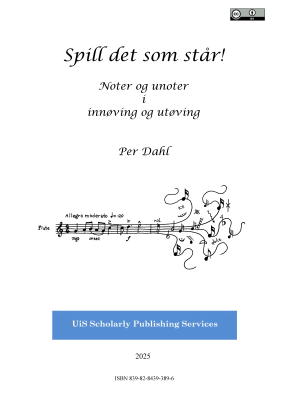Spill det som står! Noter og unoter i innøving og utøving
Keywords:
musikkverk, intensjon, skriftlighet, identifikasjon, notasjon, interpretasjon, artikulasjon, validitet, reliabilitet, formidlingSynopsis
En musikers arbeid med å innstudere et musikkverk er utgangspunktet for denne boken, samt enkelte historiske og tematiske avstikkere. Termen ‘noter’ avgrenses til de tegn som angir tonehøyde og tonelengde, mens ‘unoter’ omfatter alle andre former for informasjoner på notearket som er med på å gi musikeren informasjon om hvordan musikken skal fremføres. Notearket blir en symboltung kommunikasjonsmåte mellom komponist og utøver hvor de ulike aktørene kan legge ulike meninger i de enkelte tegnene. Tre viktige begreper, intensjon, identifikasjon og interpretasjon presenteres som elementer i en kommunikasjonsmodell både mellom komponist og utøver med notearket som medium, og mellom utøver og publikum med fremføringen som medium.
I del 2, Den musikalske kommunikasjonskjeden, reises spørsmålene: Hvor er musikkverket? Er musikkritikk et kolonisert meningshierarki? Og er lydfesting et musikalsk dilemma?
Tredje del, Notasjon, starter med en kort gjennomgang av Skriftlighetens vekst og fall, før en analyse av Notasjon, definisjon og talemåter konkretiseres i kapittelet Notasjonens tegn og uttrykk.
Fjerde del, Interpretasjon, knytter ‘unoter’ til ‘literacy’, og temaer som leseferdighet og tolkningsrom.
Femte del, Formidling, drøfter Musikerens uttrykkskvaliteter og utvider den innledende kommunikasjonsmodellen til også å omfatte tematikken omkring Estetikk, Logikk og Etikk, og om Musikalsk kommunikasjon.
Boken avsluttes med et essay om musikkverkets essens hvor Einsteins berømte masseenergiformel brukes, men hvor tegnene har fått nye referanser.
References
Agawu, K. (1999). The challenge of semiotics. In N. Cook & M. Everist (Eds.), Rethinking music (pp. XVII-574). Oxford University Press.
https://doi.org/10.1093/oso/9780198790037.003.0007
Augustinus, A., & Jacobsson, M. (2002). De musica liber VI: A critical edition with a translation and an introduction. Almqvist & Wiksell International.
Benestad, F. (1976). Musikk og tanke: Hovedretninger i musikkestetikkens historie fra antikken til vår egen tid. Aschehoug.
Bengtsson, I. (1977). Musikvetenskap: En översikt. Esselte Studium.
Berger, P. L., & Luckmann, T. (1971). The social construction of reality: A treatise in the sociology of knowledge. Penguin.
Bonds, M. E. (2014). Absolute music: The history of an idea. Oxford University Press.
https://doi.org/10.1093/acprof:oso/9780199343638.001.0001
Bourdieu, P. (1984). Distinction: A social critique of the judgement of taste. Routledge & Kegan Paul.
Chanan, M. (1995). Repeated takes: A short history of recording and its effects on music. Verso.
Cone, E. T. (1968). Musical form and musical performance. Norton.
Cook, N. (2013). Beyond the score: Music as performance. Oxford University Press.
https://doi.org/10.1093/acprof:oso/9780199357406.001.0001
Dahl, P. (2009). Grip mikrofonen! Intensitet og intimitet i Griegs Jeg elsker dig!? Studia Musicologica Norvegica, 35, 156-176.
https://doi.org/10.18261/ISSN1504-2960-2009-01-10
Dahl, P. (2006). Jeg elsker Dig!: Lytterens argument: Grammofoninnspillinger av Edvard Griegs opus 5 nr. 3 [Doctoral dissertation, Universitetet i Stavanger].
Dahl, P. (2022). Modes of communication in Stravinsky's works: Sign and expression. Routledge.
https://doi.org/10.4324/9781003218463
Dahl, P. (2019a). Music criticism in Norway. In C. P. Dingle (Ed.), The Cambridge history of music criticism. Cambridge University Press.
https://doi.org/10.1017/9781139795425.021
Dahl, P. (2009). The rise and fall of literacy in classical music: An essay on musical notation. Fontes Artis Musicae, 56(1), 66-76.
Dahl, P. (2023). The score and the performer's communication: Artistic freedom in a semiotic perspective. Journal of Music Analysis and Theory (RATM), 17-45
Dahl, P. (2019b). Utøverkunnskap. Cappelen Damm Akademisk.
Dahl, P. (2011). Verkanalysen som fortolkningsarena. Unipub.
Dahl, P. (2019c). Where is the essence of a musical work? In R. Stanevičiūtė, N. Zangwill, & R. Povilionienė (Eds.), Of essence and context: Between music and philosophy. Springer.
https://doi.org/10.1007/978-3-030-14471-5_15
Davies, S. (2001). Musical works and performances: A philosophical exploration. Clarendon Press.
https://doi.org/10.1093/0199241589.001.0001
Day, T. (2000). A century of recorded music: Listening to musical history. Yale University Press.
Dogantan, M., Society for Education, Music, and Psychology Research. (2016). Artistic practice as research in music: Theory, criticism, practice. Routledge.
https://doi.org/10.4324/9781315568041
Dogantan-Dack, M. (2008). Recorded music: Philosophical and critical reflections. Middlesex University Press.
Dreyfus, H., & Dreyfus, S. (1991). Towards a phenomenology of ethical expertise. A Journal for Philosophy and the Social Sciences, 14(4), 229-250.
https://doi.org/10.1007/BF02205607
Ferneyhough, B. (1998). Aspects of notational and compositional practice. In R. Toop & J. Boros (Eds.), Collected writings (Vol. 2). Routledge.
Gardner, H. (1985). Frames of mind: The theory of multiple intelligences. Paladin.
Goehr, L. (2007). The imaginary museum of musical works: An essay in the philosophy of music. Oxford University Press.
https://doi.org/10.1093/oso/9780195324785.001.0001
Hamilton, A. (2007). Aesthetics and music. Continuum.
https://doi.org/10.5040/9781472545367
Hanslick, E. (1973). Vom Musikalisch-Schönen: Ein Beitrag zur Revision der Ästhetik der Tonkunst (K. Bjørseth, Trans.). Wissenschaftliche Buchgesellschaft. (Original work published 1854)
Hooper, G. (2016). Beyond the score: Music as performance. Music Analysis, 35(3), 407-416. https://doi.org/10.1111/musa.12077
https://doi.org/10.1111/musa.12077
Hultberg, C. (2000). The printed score as a mediator of musical meaning: Approaches to music notation in Western tonal tradition [Doctoral dissertation, Malmö Academy of Music].
Ingarden, R., Czerniawski, A., & Harrell, J. G. (1986). The work of music and the problem of its identity. University of California Press.
https://doi.org/10.1007/978-1-349-09254-3
Johnson, M. (2007). The meaning of the body: Aesthetics of human understanding. University of Chicago Press.
https://doi.org/10.7208/chicago/9780226026992.001.0001
Luhmann, N. (2000). Art as a social system. Stanford University Press.
https://doi.org/10.1515/9781503618763
Ogden, C. K., & Richards, I. A. (1974). The meaning of meaning: A study of the influence of language upon thought and of the science of symbolism. Harper Paperbacks. (Original work published 1923)
Philip, R. (1992). Early recordings and musical style: Changing tastes in instrumental performance, 1900-1950. Cambridge University Press.
https://doi.org/10.1017/CBO9780511470271
Rink, J. (2002). Musical performance: A guide to understanding. Cambridge University Press.
https://doi.org/10.1017/CBO9780511811739
Schuiling, F. (2019). Notation cultures: Towards an ethnomusicology of notation. Journal of the Royal Musical Association, 144(2), 429-458.
https://doi.org/10.1080/02690403.2019.1651508
Sloboda, J. A. (2005). Exploring the musical mind: Cognition, emotion, ability, function. Oxford University Press.
https://doi.org/10.1093/acprof:oso/9780198530121.001.0001
Sloboda, J. A. (1985). The musical mind: The cognitive psychology of music. Clarendon Press; Oxford University Press.
Sontag, S. (2009). Against interpretation: And other essays. Penguin Classics.
Wallas, G. (1926). The art of thought. Jonathan Cape.


